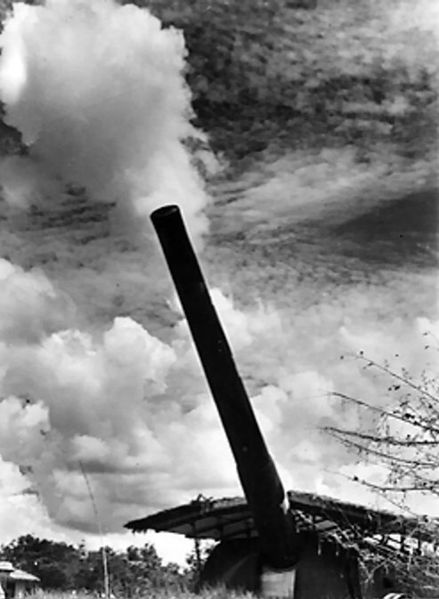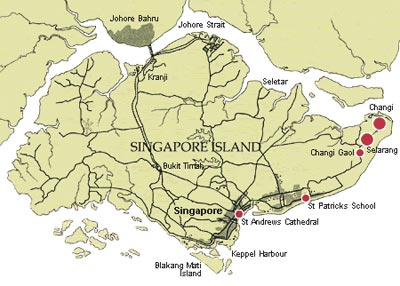| The Guns
of Singapore
By Mike Bennighof, Ph.D.
May 2022
 Among those with a passing knowledge of
military history, there are an amazing number
of falsehoods that “everybody knows”:
Catherine the Great died during sex with a
horse. The Waffen SS were just soldiers. Napoleon’s
gunners shot
the nose off the Sphinx. Very few Germans
knew about the Holocaust. And, one that’s
odd for its level of detail, Singapore’s
giant coastal defense guns could not be turned
to face the landward side. Among those with a passing knowledge of
military history, there are an amazing number
of falsehoods that “everybody knows”:
Catherine the Great died during sex with a
horse. The Waffen SS were just soldiers. Napoleon’s
gunners shot
the nose off the Sphinx. Very few Germans
knew about the Holocaust. And, one that’s
odd for its level of detail, Singapore’s
giant coastal defense guns could not be turned
to face the landward side.
The origins of that last are hard to trace; it certainly appears
in many places. Singapore indeed had large
naval guns that did little to stop the Japanese
from taking the island in February 1942. Of
the five 15-inch coastal guns, four of them
had all-round traverse. What they lacked was
high-explosive ammunition.
Singapore only became a major factor in British
war plans in 1921, when the Committee on Imperial
Defence chose the island as the site of a
new naval base. The Singapore base would have
to accommodate a large battle fleet and provide
supply and repair facilities. No potential
foe was mentioned in any of the official documents,
but everyone understood it to be Japan. The
new base would also have to be secure from
enemy attack.
Singapore offers a number of advantages in
this regard. Sitting astride the Malacca Strait,
it dominates one of the world’s key
commerce routes. On a map, Singapore bears
a striking resemblance to the Isle of Wight,
which shelters the key British naval base
of Portsmouth. During wars with the French
and the Dutch, English fleets in Portsmouth
had two possible exits into the English Channel.
Any fleet blockading Portsmouth needed at
least twice the strength of the English fleet
sheltering there to keep it trapped. So it
would be with Singapore, as the Royal Navy
chose a site almost halfway along the Johore
Strait separating Singapore and the Malayan
mainland.

A 15-inch gun of the Johore battery.
Forts with coastal artillery had existed
on Singapore since the 1830s; the island was,
after all, one of the Far East’s greatest
commerical entrepots. In 1927, Army engineers
began selecting sites for new, modern batteries
of coast-defense guns.
At the eastern end of the Johore Strait, the
Changi Peninsula (site of today’s Singapore-Changi
airport) would get three 15-inch guns in full-traverse
armored mounts, with ammunition magazines
buried deep beneath them. There would also
be four 6-inch rifles. A narrow-gauge railway
connected the batteries to further stores
of ammunition. Heavy anti-aircraft protection
was provided for the batteries, plus barracks
for a battalion of infantry (2nd Battalion,
Gordon Highlanders). Work began in late 1927,
but halted due to the Great Depression. A
1935 grant by the Sultan of Johore, alarmed
by signs of pending Japanese aggression, allowed
the work to proceed and it was substantially
complete by 1938.
Directly covering the western entrance to
the Johore Strait was a battery of two 6-inch
guns. A few miles down the coast, the battery
at Buona Vista had two 15-inch guns, but one
of them was sited with an arc of fire of only
180 degrees, though the other had full traverse.
Several batteries dotted Keppel Harbor and
Blakang Mati Island at the southern tip of
Singapore. Eight 6-inch guns and three 9.2-inch
guns were sited here, mostly in upgraded coastal
forts dating from the late 19th century. Finally,
on Puland Takau Besar (an island in the Johore
Strait just off the right edge of the map
below) two 6-inch and three 9.2-inch guns
were sited.

Singapore in 1942. Naval base is top center,
Changi Peninsula
at the eastern end of the island. Australian
government map.
When the Japanese began their artillery
bombardment of Singapore, the big naval guns
at Changi replied. But lacking high-explosive
shells, they could do little against the Japanese
landings and the rapidly moving Japanese forces
suffered few casualties from them. While the
armor-piercing shells would explode, they
were designed to do so only after penetrating
a ship’s steel hide and so when used
against land targets they would bury themselves
deeply in Singapore’s soft ground before
detonating.
That changed when infantry from the Japanese
18th “Chrysanthemum” Infantry
Division overran Tengah airfield at the opposite
end of the island but still well within range.
The big guns rained down 194 shells on the
airfield, and the hard surface detonated far
more of them than any other location. But
this appears to have been their only real
successful fire mission. They never fired
on a naval target during their existence.

The shells were this big.
On 12 February Lt. Gen. A.E. Percival —
who as a colonel on the pre-war staff of Malaya
Command had warned that the coastal guns might
need to fire on land targets — ordered
the Changi batteries abandoned. Engineers
destroyed all the guns, so thoroughly that
the underground bunkers beneath them were
not discovered intact and unearthed until
1991.
The battery site became the new Japanese military prison,
and over 50,000 Australian and British prisoners
of war were jammed into the barracks, workshops
and other inadequate shelter. The nearby beaches
became the site of the Sook Ching massacres:
For at least two weeks after the British surrender,
every day the Japanese marched hundreds of
Chinese civilians to the Changi area. At low
tide they ordered them to the water’s
edge and machine-gunned them, counting on
the strong tides of the Johore Strait to sweep
the bodies out to sea. During the 1947 trials
held at Singapore, Japanese war criminals
admitted to killing 5,000 Chinese they picked
at random; postwar estimates range as high
as 50,000.
Singapore’s coastal artillery could
not protect the island from the Japanese,
but did accomplish its mission: The Japanese
did not attempt a landing on or naval bombardment
of Singapore.
Great Pacific War returns soon in a Final Edition. For a limited time, Gold Club members can snag an upgrade kit with a new scenario book and full-color play aids.
Sign up for our newsletter right here. Your info will never be sold or transferred; we'll just use it to update you on new games and new offers.
Mike Bennighof is president of Avalanche Press and holds a doctorate in history from Emory University. A Fulbright Scholar and NASA Journalist in Space finalist, he has published a great many books, games and articles on historical subjects; people are saying that some of them are actually good.
He lives in Birmingham, Alabama with his wife, three children, and his Iron Dog, Leopold.
Want to keep Daily Content free of third-party ads? You can send us some love (and cash) through this link right here.
|
